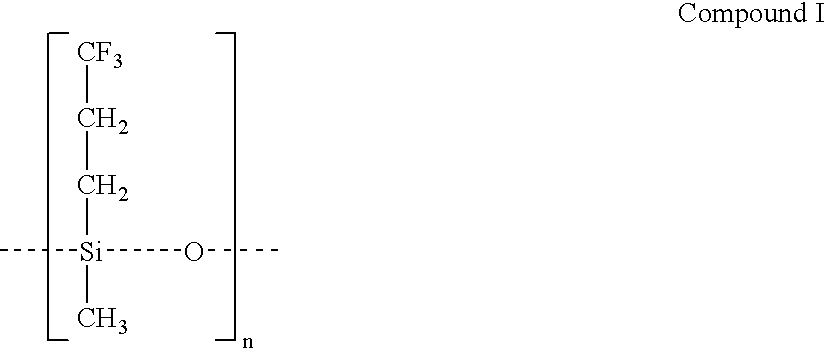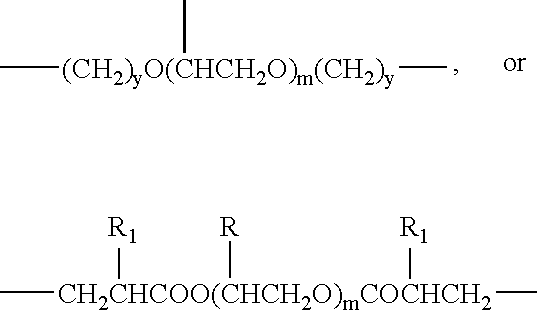Drug delivery system
a delivery system and elastomer technology, applied in the field of delivery systems, can solve the problems of serious problems, non-disclosure of a core made of an elastomer, and non-controlled release of active substances, and achieve the effect of less retarding influence on the permeation of active agents and great permeation retarding
- Summary
- Abstract
- Description
- Claims
- Application Information
AI Technical Summary
Benefits of technology
Problems solved by technology
Method used
Image
Examples
example 1
[0171] An implant comprising levonorgestrel at a target release rate of 50 .mu.g / day and estradiol at a target release rate of 10 .mu.g / day was prepared.
[0172] The implant structure was as disclosed in FIG. 2. The first part of the core consisted of PDMS comprising levonorgestrel and the length was 35 mm. The second part of the core consisted of PEO-PDMS having 50% of PEO, comprising estradiol, and the length was 8 mm.
[0173] The core parts were encased in a membrane consisting of PEO-PDMS in a ratio of 10:90. The thickness of the membrane was 0.2 mm and the outer diameter of the implant 2.48 mm.
[0174] The release rates obtained are illustrated in FIG. 9, wherein the squares illustrate the release rate of estradiol and the lozenges represent the release rate of levonorgestrel. It can be seen that the target release rate of estradiol was obtained and that the release rate of levonorgestrel was from 60 to 40 .mu.g / day instead of the 50 .mu.g / day targeted.
example 2
[0175] An implant according to the Example 1 was prepared, using as active agents 11-(4-Acetylphenyl)-17-hydroxy-17-(1,1,2,2,2-pentafluoroethyl)estr-a-4,9-dien-3-one (an antiprogestin) at a target release rate of 50 .mu.g / day and estradiol at a target release rate of 10 .mu.g / day.
[0176] The implant structure was as disclosed in FIG. 2. The first part of the core consisted of PEO-PDMS in a ratio of 50:50 comprising compound 1 and the length was 34 mm. The second part of the core consisted of PEO-PDMS having 50% of PEO, comprising estradiol, and the length was 6 mm.
[0177] The core parts were encased in a membrane consisting of PEO-PDMS in a ratio of 20:80. The thickness of the membrane was 0.2 mm and the outer diameter of the implant 2.48 mm.
[0178] The release rates obtained are illustrated in FIG. 10, wherein the lozenges illustrate the release rate of estradiol and the squares represent the release rate of compound 1. It can be seen that the target release rates were obtained.
example 3
[0179] An implant according to the Example 1 was prepared, using as active agents gestodene and estradiol.
[0180] The implant structure was as disclosed in FIG. 2. The first part of the core consisted of PDMS comprising gestodene and the length was 13 mm. The second part of the core consisted of PEO-PDMS having 50% of PEO, comprising estradiol, and the length was 30 mm.
[0181] The core parts were encased in a membrane consisting of PDMS and methyltrifluoropropyl-methylvinyl siloxane in a ratio of 70:30. The thickness of the membrane was 0.23 mm and the outer diameter of the implant 2.48 mm.
[0182] The release rates obtained are illustrated in FIG. 11, wherein the lozenges illustrate the release rate of gestodene and the squares represent the release rate of estradiol.
PUM
| Property | Measurement | Unit |
|---|---|---|
| length | aaaaa | aaaaa |
| length | aaaaa | aaaaa |
| outer diameter | aaaaa | aaaaa |
Abstract
Description
Claims
Application Information
 Login to View More
Login to View More - R&D
- Intellectual Property
- Life Sciences
- Materials
- Tech Scout
- Unparalleled Data Quality
- Higher Quality Content
- 60% Fewer Hallucinations
Browse by: Latest US Patents, China's latest patents, Technical Efficacy Thesaurus, Application Domain, Technology Topic, Popular Technical Reports.
© 2025 PatSnap. All rights reserved.Legal|Privacy policy|Modern Slavery Act Transparency Statement|Sitemap|About US| Contact US: help@patsnap.com



